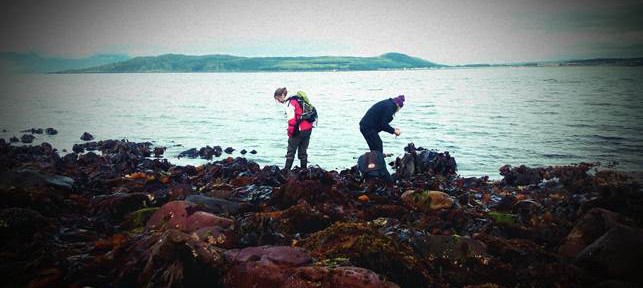
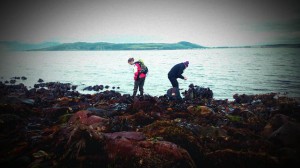
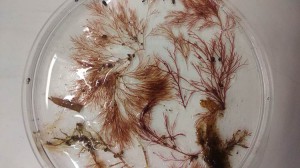
Out on the shore and a few seaweeds from Cumbrae
September and October were months of transition for me and my traineeship. I spent the beginning of September at the FSC Marine Station on Cumbrae with some of the UK’s specialists in Algae. We spent 3 days looking for and identifying species at 3 locations on the island. At one site we found a staggering 103 species of seaweed. All of the locations we went to had Sargassum, the invasive brown seaweed. Two of the sites were heavily covered and one contained Sargassum only in its rock pools. My time at Millport was great fun and a fantastic opportunity for me to brush up on my seaweed ID skills.
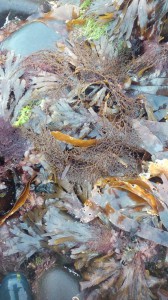
Sargassum muticum on top of various fucoids and red seaweeds
The next day I was back in Orkney for the Orkney Science Festival. Heriot Watt had 6 stands this year including my own. We had invasive species, marine litter, animal skulls, geology, robots and the life of the explorer John Rae. The festival was a huge success with so many interesting stands for adults and kids to enjoy. There were stands on bumblebees, how to extract DNA from Strawberries, wild eating, fairtrade stands and so much more. Heriot watt, the University of Edinburgh, Glasgow Science Centre, the RSPB and many other organisations and institutions were there engaging hundreds of people in science. It was such a success that I hope TCV can do a stand in the future.
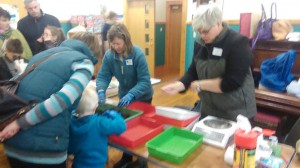
Mary Spencer Jones and Joanne Porter looking for plastic at the Orkney Science Festival
Towards the end of September John and Chris from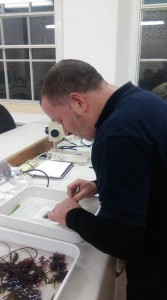 TCV came to visit me in Orkney for a day. One day is not enough to fully enjoy Orkney but I planned a full day of activities so that we could cram as much of the island in as possible. We started at ICIT before heading to Stromness Marina to collect seaweeds and look at the invasives there. Next it was a trip to the stones of Stenness, the ring of Brodgar and Skara Brae. We managed to collect more samples for Chris at the coast of the Neolithic settlement. After some lunch in the visitors centre it was back to ICIT for a presentation to some of ICIT’s master’s students followed by some lab work and a demonstration from Chris on how to press seaweeds. Soon we were off to Hatston Pier to look at the renewable device the SR 250 and Scapa beach for more sampling. Last but not least we visited the Italian chapel and again, more sampling opportunities! We made it back to ICIT for some dinner with my mentor, Dr Joanne Porter, and the day ended with Chris and John making their way back to the ferry. It was great to have colleagues on Orkney and I only hope that TCV will come back. The wealth of opportunities on Orkney for conservation work and public engagement are huge. Everything I have done and been to on Orkney has had such great turnouts and the island has such a community spirit unlike anywhere I have ever been before.
TCV came to visit me in Orkney for a day. One day is not enough to fully enjoy Orkney but I planned a full day of activities so that we could cram as much of the island in as possible. We started at ICIT before heading to Stromness Marina to collect seaweeds and look at the invasives there. Next it was a trip to the stones of Stenness, the ring of Brodgar and Skara Brae. We managed to collect more samples for Chris at the coast of the Neolithic settlement. After some lunch in the visitors centre it was back to ICIT for a presentation to some of ICIT’s master’s students followed by some lab work and a demonstration from Chris on how to press seaweeds. Soon we were off to Hatston Pier to look at the renewable device the SR 250 and Scapa beach for more sampling. Last but not least we visited the Italian chapel and again, more sampling opportunities! We made it back to ICIT for some dinner with my mentor, Dr Joanne Porter, and the day ended with Chris and John making their way back to the ferry. It was great to have colleagues on Orkney and I only hope that TCV will come back. The wealth of opportunities on Orkney for conservation work and public engagement are huge. Everything I have done and been to on Orkney has had such great turnouts and the island has such a community spirit unlike anywhere I have ever been before.
My time with ICIT was almost over but I had 2 things left to do before I left for good. The first was to attend the MASTS Conference with some of ICIT’s Masters and PhD students. The conference ran for 3 days and was hosted by Strathclyde University in Glasgow. I presented an e-poster of my work on invasives and attended some really fascinating workshops. The conference was such an eye opener to the wealth of marine science that is going on around the world and was a fantastic opportunity to talk to people and make new connections.
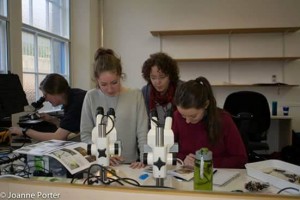 Not long after the conference I was back in Orkney for the last time. Masters students from Heriot Watt in Riccarton had made their way up to Orkney for a 3 day field course. They were to carryout rocky shore surveys and make assessments on the ecology of the seabed near one of the Churchhill barriers as part of their course work. It was great working with them and they had one of the warmest days Orkney has had all year for their intertidal survey. This was the last activity I had on the island and it was a great way to end. I went there to learn about marine ecology, invasive species and Orkney’s connections with the sea and I finished by supporting students who were there to do exactly the same.
Not long after the conference I was back in Orkney for the last time. Masters students from Heriot Watt in Riccarton had made their way up to Orkney for a 3 day field course. They were to carryout rocky shore surveys and make assessments on the ecology of the seabed near one of the Churchhill barriers as part of their course work. It was great working with them and they had one of the warmest days Orkney has had all year for their intertidal survey. This was the last activity I had on the island and it was a great way to end. I went there to learn about marine ecology, invasive species and Orkney’s connections with the sea and I finished by supporting students who were there to do exactly the same.
October was my first month back at Riccarton and it took a bit of time to get re-organised and focussed on the work I still had to achieve. I started by attending a conference aimed at Invasive Species control which had little in the way of aquatic invasive but it was still a great opportunity to learn from those already involved in terrestrial invasive control. Next I was at another conference for postgraduate students and this conference was absolutely fantastic. It was a great opportunity for students to put their work across, network and seek new opportunities.
I have also been in meetings with the Inner Forth Landscape Initiative and the charity FIDRA, who run the nurdle hunt, discussing an intertidal workshop next year . We carried out a site visit and are well on our way to organising the event which I hope locals and participants who attend will enjoy.
October was also a month to get organised and so I had meetings with all my partners and together we came up with a list of achievable objectives and outcomes for me to complete by January. The first was to write a literature review and a paper on Non-Natives. The second is to work with SEPA for a week, the third is to carry out DNA extraction work of Bryozoan samples and lastly to support the TCV offices. My own paper will hopefully become a published piece, my work with SEPA will be acknowledged and my work with the bryozoans will contribute to future publications. You can’t ask for much better outcomes to a traineeship than that.
